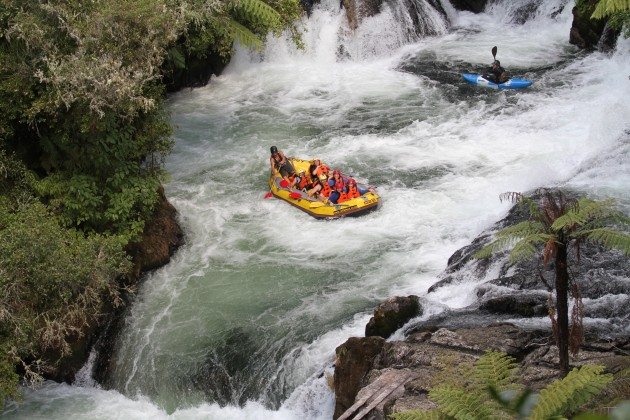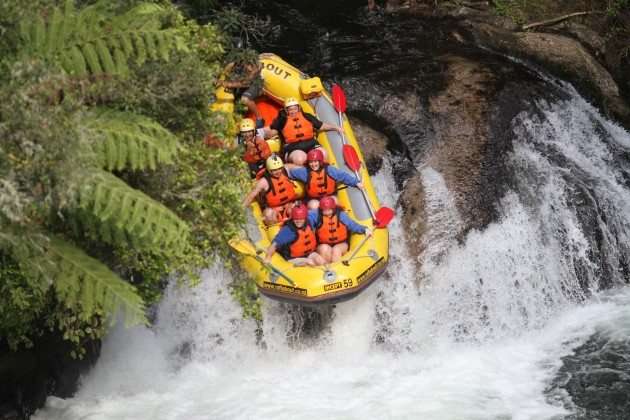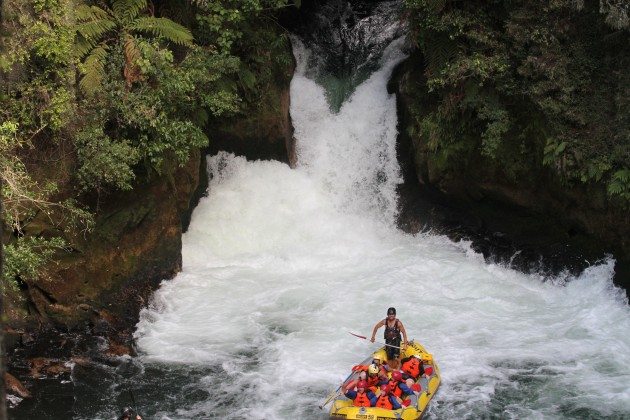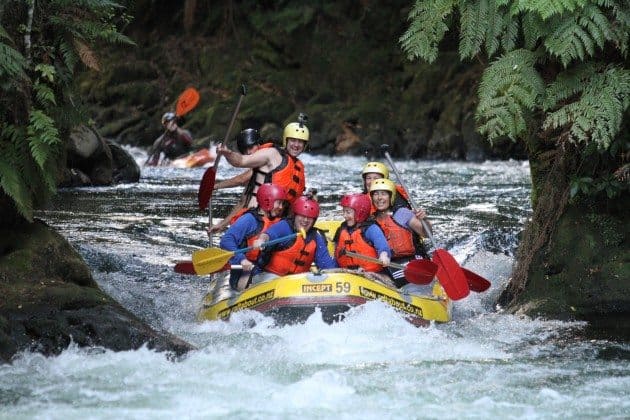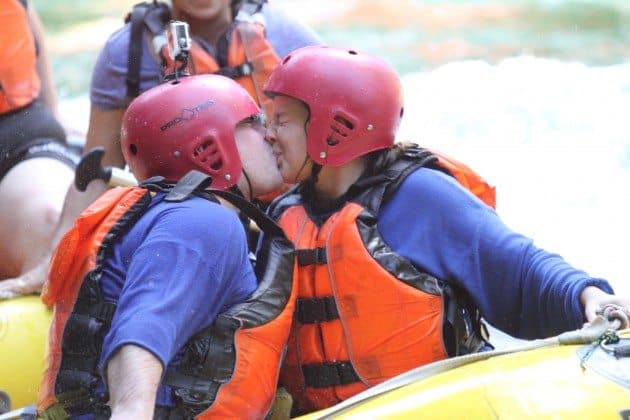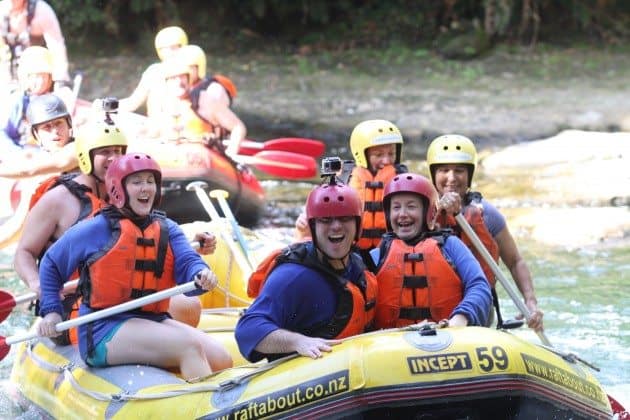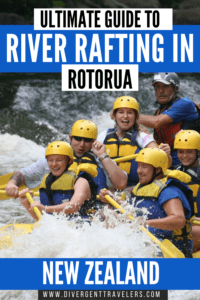New Zealand is known for its extreme activities and sports throughout the country. One trip you should not miss on the North Island when you visit Rotorua is a rafting trip with River Rats Rafting.
Don’t let the water splashes and the crashing of the rapids scare you away. Grab your wet suit, helmet, paddle and hope you do not fall out over the 7-meter waterfall drop.
Our journey for the day started in Rotorua. River Rats picked us up at our hostel and away we went for a 20-minute drive to their main office. Once there, we were briefed on the trip and sent out to get fitted with our gear for the day and meet our river guides.
Rotorua Rafting the Kaituna River: Our Personal Experience
Table of Contents
After everyone was dressed for rafting we loaded up in the van and headed to the drop in the area of the Kaituna River to begin our adventure. Before getting into the water, the experienced guides will show you what you need to know to make it down the river.
When they say paddle to the right you paddle to the right if they say get down you get down and grab the raft. They teach you to paddle forward and paddle back. Your guide will tell you what to do and when to do it way in advance before you plunge down the different twists, turns and drops of the river.
The crew are called River Rats because they spend every hour of every day on the river, you are in safe hands.
The beginning of the trip starts off mild so it’s easy to get into the flow of rafting the river. As you keep paddling, the sounds of water falling over the rocks become the soundtrack of your day while your guide tells you how to navigate the river.
Before you know it, you are at your first set of class 5 rapids. A 2.5-meter waterfall quickly followed by a 1-meter waterfall.
Water crashes you in the face as you plunge down the first set of rapids. You have only a moment to catch your breath before the next waterfall meets you.
You paddle once again, as hard as you can with your whole body then you quickly jump down holding on to the water-soaked rope as you have the sensation of free-falling. In a matter of seconds, you will be at the bottom wiping the water from your face.
It isn’t every day that you get a chance to raft class 5 rapids and negotiate a 7-meter waterfall, the highest commercially rafted waterfall in the World. Your heart starts pumping as you hear the sound of the water crashing in front of you.
As your raft creeps up with the nose of the raft just starting over the large drop you think to yourself, am I really doing this?
Too late, you’re plunging down the waterfall in one quick motion. All you see is the waterfall mist for a slight second while the whole raft is pushed down by the falling water, then you pop out on the bottom to a nice pool of water.
It hits you; you just went down a real, not man-made, 7-meter waterfall. You and your team put your paddles together to give a celebration yell.
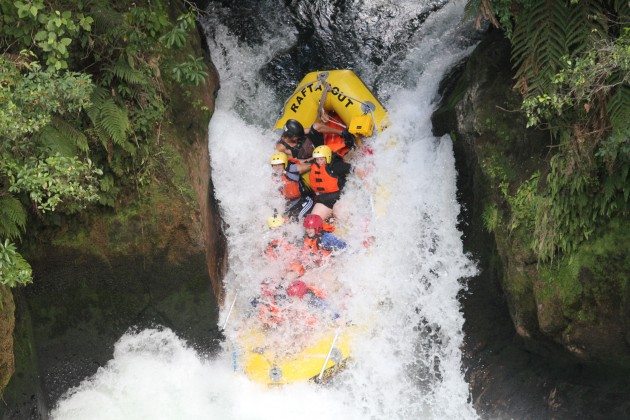
The rest of the river seems pretty tame after that rush but you push on through more rapids. Rapids water splashing all over while you are crashing thought the water, trying to stay in. If you do fall out there’s a guide in a kayak to save you along with your fellow rafters.
We went down the river in groups of three rafts and waited after every large fall to make sure someone was not unlucky and fell out of the boat. If you are not scared of the water, you and your team can paddle up the rapids into the waterfalls to let the falling water spray into the front of your boat.
The water can spray two rows back flowing over the front two rafters.
If you feel like free-floating down the class 5 rapids, jump out of the boat and give it a try. Let the river take you for a wild ride. You may be thinking this is crazy, as your goal is to stay in the boat.
Why would I jump out? It’s a wild trip; you cross your arms and put your feet forward while the rapids suck you downstream. Don’t worry about hitting a rock just let the powerful rapids take you for a wet n wild ride.
The beauty of the Kaituna River is unmatched around the World and it’s hard to keep your eyes on the rapids as they come up. There are large rock cliffs with all kinds of growth over the waterway. The water is clear, crisp and really refreshing on a summer day.
White Water Rafting: Rotorua New Zealand Planning Tips
Location of the Kaituna River and How to Travel There
The Kaituna River is the most exhilarating waterway in New Zealand, packed with white water rapids and home to the world’s largest commercially rafted waterfall. It’s a place like no other for adventure seekers, and it’s found just outside of Rotorua, in the heart of the North Island.
Rotorua is a popular stop on many travel itineraries, and you’ll find the city itself easy to reach, with good links to Auckland, the Bay of Plenty and other destinations too.
The Kaituna River begins at Lake Rotoiti, which is just north of Rotorua, before continuing its long journey to the Bay of Plenty, a journey of around 50 kilometers in length.
The most popular sections for white water rafting Rotorua are found closer to the source of the river, by Lake Rotoiti, allowing easy access from the city, but also allows you to tackle Tutea Falls, the tallest waterfall in the world that can be rafted.
There are several tour companies in the city offering packages for white water rafting Rotorua, and unless you are very experienced and have your own gear etc, this is the only way you will get out on the rapids.
River Rats Rafting, for instance, will provide you with transfers to and from your accommodation in Rotorua, meaning you don’t have to worry about a thing, just the rapids awaiting you on the river.
If you aren’t brave enough to take on white water rafting Rotorua, then Tutea Falls and Okere Falls are just a 20-minute drive from the city, and you can watch the rafters on the river as they tumble over the edge instead of tumbling over with them.
There’s even a public bus operating between Rotorua and the community of Okere Falls if you don’t have your own transport.
The Best Time to Raft
Companies in Rotorua run trips all throughout the year, with more scheduled departures each day in summer than in winter. This reflects the fact that things are very much busier in New Zealand during the summer season, which roughly runs from November to March.
This is when the weather is at its best, and considering you’re going to be very wet for a few hours, having a bit of sunshine will add to your experience immensely. Of course, though, the rapids require rain to make them formidable, and you will find the most intense white water rafting Rotorua just after a rainstorm!
The local guides though will always have final say over the matter when it comes to the weather, and if the rapids are deemed too intense after a heavy storm, then the trip may have to be rescheduled.
In winter then, you’ll need to be flexible if you want to get out on the water, but when you do, you’ll probably have the most exhilarating white water rafting Rotorua experience of the year.
If you want to enjoy slightly calmer rapids but great weather, then consider traveling to Rotorua in the spring shoulder season, just before summer, when the rivers will be full and the sun will begin to emerge from the New Zealand clouds.
Rafting the Kaituna River
The section of the Kaituna River that most commonly forms the white water rafting Rotorua experience, is the area focused around Okere Falls.
This is the upper section of the river – commonly referred to as the Okere River – close to its source at Lake Rotoiti, and it’s the most intense and exciting stretch of water in New Zealand.
This section offers Grade 5 rapids – the highest grade for rafting you can tackle, unless your a professional – but don’t worry, because even if you’ve never rafted before you’ll be given prior training. You just need to be physically fit and ready for a lot of adrenaline and a lot of water.
If you are joining a local white water rafting Rotorua tour, then in peak season trips leave several times a day, from the morning through to the afternoon. You’ll be out of Rotorua for around 2 and a half hours in total.
After getting picked up, you’ll be taken to the mustering areas on the river to kit up and go through the safety brief, then you’ll hit the water in your raft.
The route lasts for approximately one hour of rafting and starting at the top of the river section, you’ll pass over the 3 different waterfalls that are found in the Okere Falls part of the Kaituna River.
The white water rafting Rotorua tour will begin gently enough, as you paddle along the calm beginning. The first drop at Okere Falls is simple enough, and you will adjust to the raft and get used to paddling, while still getting very wet.
The second drop becomes more intense, and a lot steeper. But again, you’re unlikely to fall out as long as you follow the commands given by your boat leader. Things will start to get more intense after the second waterfall, as you hit more and more rapids in the build-up to the big drop at Tutea Falls.
There are around 14 big rapids in total – not counting smaller bumps along the way! – but nothing compares to the end waterfall. Tutea Falls is 7 meters tall and definitely a Class 5 drop! As you near the edge, follow your instructor’s commands and hold tight.
It’s an adrenaline rush like no other, and of course, you will end up completely soaked too. Occasionally, the rafts will flip over when they hit the water at the bottom of the falls.
This is rare, but if it does happen, then just follow the training you are given at the start and don’t worry too much because the worst of the rapids are over and there will be plenty of time to climb back inside the raft. You might even enjoy the extra rush of capsizing on the world’s tallest commercially rafted waterfall.
Training For Your Adventure on the Kaituna River
Remember that this is a Class 5 section of rapids, so you will need to be prepared to get wet and to put in a lot of physical work paddling. You don’t need to be super fit, but you do need to able to cope with the adrenaline, the high speeds, and the crashing water, while you are paddling.
The minimum age is 13 years old, so this is an activity that’s suitable for teenagers too, as long as they are accompanied by an adult. You don’t need any prior experience prior to doing this, and tour companies claim you don’t even need to be able to swim – as you’ll be fully kitted out in lifejackets the whole time.
You do need to be able to follow commands, however, as teamwork is integral to a safe rafting experience.
Before you hit the water, your group will be given around twenty minutes of instruction and training from the guides. Your local guides are going to be experienced and well versed in taking newcomers and old hands alike out onto the Kaituna River.
They know the rapids well and will have dropped over the big waterfall countless times. You’ll also be in small rafting groups, with other boats around to help if anything does happen, which is unlikely.
Listen carefully during the instructional session beforehand. You’ll get kitted out and made to go through the motions of paddling by your guides before you are even allowed near the boat.
They will run you through techniques, the commands they’ll be issuing and what to do if you fall out or the boat flips. You’ll be in safe hands, so just enjoy the ride!
What to Bring with You
The company you book with will provide most of the equipment of course, including wetsuits to keep you warm in the water, helmets, boots, and top of the range lifejackets.
Depending on the weather conditions during your white water rafting Rotorua trip, you may be given extra spray jackets too – most definitely if you are rafting in winter.
All you really need to bring with you is a towel and your personal swimming gear. You may want to bring a few snacks to enjoy after the rafting, and some water or other refreshments too.
You will get wet, very wet, so make ensure that you bring some warm clothes to change into at the end of the trip, particularly if the weather looks like it might take a turn for the worse.
Photography
The tour companies generally bring along a photographer with them too, to take shots along the river, including when you make the final drop over the adrenaline-inducing Tutea Falls. They will take action shots as you fall over the edge, and make the splash below.
Double-check with your tour provider beforehand, to ensure they provide this service for you because you will want to take home the photos. If you have your own action camera, such as a Go Pro, then as long as you have suitable accessories to ensure you don’t lose it, then you can bring this along too.
You may want either a chest harness or a helmet mount or at the very least a wrist strap with a floatation device.
| Recommended Tours | ||
 |  |  |
 |  |  |
| HIGHLIGHTS OF NEW ZEALAND Auckland to Christchurch 15 days Small Group 12-16 People | NEW ZEALAND–SOUTH ISLAND ENCOMPASSED Wellington to Wellington 16 days Small Group 12-16 People | NEW ZEALAND–NORTH ISLAND ENCOMPASSED Auckland to Wellington 10 Days Small Group 12-16 People |
| Check Price | Check Price | Check Price |
More on New Zealand:
- 51 Epic Things to Do in New Zealand
- 15 Fun Things to do in Tauranga, New Zealand
- 15 Memorable Things to Do in Taupo
- 20 Awesome Things To Do In Queenstown, New Zealand
- Complete Queenstown Accommodation Guide
- Two Week New Zealand South Island Itinerary
- 19 North Island New Zealand Photos That Inspire Travel
- 25 New Zealand Photos That Showcase the South Island
- Travel Recap- 5 Weeks in New Zealand
- The Tongariro Crossing is the Best Hike in New Zealand
- Two Week North Island New Zealand Itinerary
- Kaikoura Whale Watching: The Ultimate Guide
- 21 EPIC Things To Do In Kaikoura, New Zealand
- Karangahake Gorge: Off the Beaten Track in NZ
- Piha Beach Planning & Surf Guide
- Best Time to Visit New Zealand: Month by Month Breakdown

